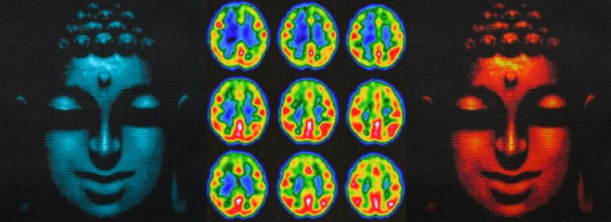| A review of neuroscience studies of meditation reveals the positive effects of meditation on brain activity and structure. This research shows short term and long term improvement in brain functions related to attention, regulation of emotions and increases in grey matter. These results are obtained during the “state” of meditation and also in longer lasting “trait” effects of meditation on brain functions.Many Electroencephalography (EEG) studies using electrical leads placed all over the scalp to measure the collective electrical activity of the cerebral cortex have demonstrated lower frequency alpha and theta waves associated with the meditation. These lower frequencies are an indication of brain activity associated with the deep relaxation and focused attention brought about by meditation.Functional magnetic resonance imaging (fMRI), a new technology that measures increases in blood flow and metabolism, has been used to study state brain changes during meditation. Recent studies have shown heightened activity in the cingulate cortex and frontal cortex indicating more voluntary control over the mechanisms of attention. The same results were achieved with a wide variety of different meditation techniques.Regarding meditation and emotions fMRI results have indicated heightened activity in the cingulate cortex related to attention and the areas of the brain controlling emotions (amygdala, temporo-parietal) in response to emotional sounds. These studies conclude that meditation produces greater sensitivity to emotional expression due to the neural circuitry activated.
Most exciting is a recent study conducted by Harvard researchers at Massachusetts General Hospital indicating that “meditation literally rebuilds the brains grey matter in just eight weeks…the very first study to document that meditation produces changes over time in the brain’s grey matter.”
The study involved taking magnetic resonance images (MRI) of the brain’s of 16 study participants two weeks prior to participating in the study. MRI images of the participants were also taken after the study was completed. For the study, participants engaged in meditation practices every day for approximately 30 minutes. These practices included focusing on audio recordings for guided meditation, non-judgmental awareness of sensations, feelings and state of mind.
Britta Holzel, the lead author of the study stated, “The analysis of MR images, which focused on areas where meditation-associated differences were seen in earlier studies, found increased grey-matter density in the hippocampus, known to be important for learning and memory, and in structures associated with self-awareness, compassion and introspection.”
He continues, “It is fascinating to see the brain’s plasticity and that, by practicing meditation, we can play an active role in changing the brain and can increase our well-being and quality of life. Other studies in different patient populations have shown that meditation can make significant improvements in a variety of symptoms, and we are now investigating the underlying mechanisms in the brain that facilitate this change.”
My next blog will highlight the neuro-endocrinal science that is the foundation for how asanas achieve physical, emotional and mental balance.

Dr. Sid Jordan
Director of the Prama Insitute, North Carolina
www.pramainstitute.org |


